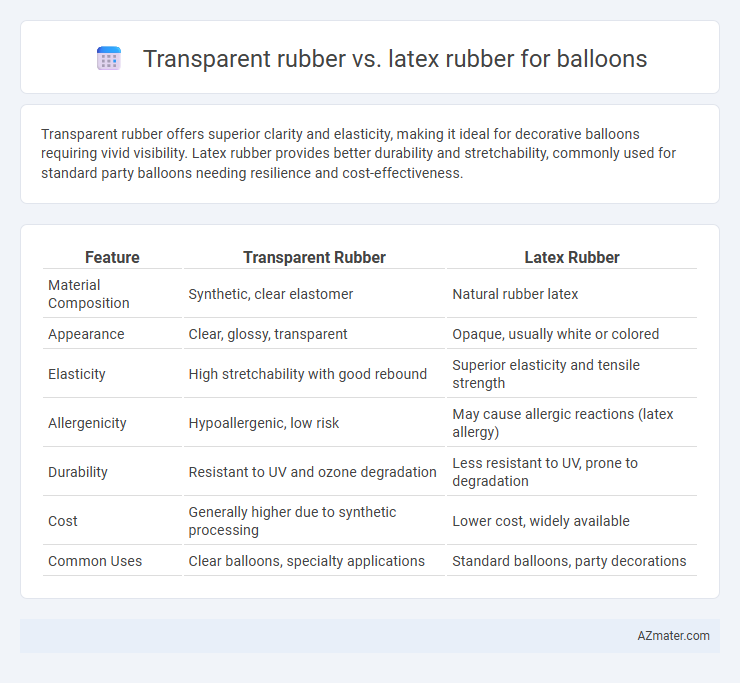Transparent rubber offers superior clarity and elasticity, making it ideal for decorative balloons requiring vivid visibility. Latex rubber provides better durability and stretchability, commonly used for standard party balloons needing resilience and cost-effectiveness.
Table of Comparison
| Feature | Transparent Rubber | Latex Rubber |
|---|---|---|
| Material Composition | Synthetic, clear elastomer | Natural rubber latex |
| Appearance | Clear, glossy, transparent | Opaque, usually white or colored |
| Elasticity | High stretchability with good rebound | Superior elasticity and tensile strength |
| Allergenicity | Hypoallergenic, low risk | May cause allergic reactions (latex allergy) |
| Durability | Resistant to UV and ozone degradation | Less resistant to UV, prone to degradation |
| Cost | Generally higher due to synthetic processing | Lower cost, widely available |
| Common Uses | Clear balloons, specialty applications | Standard balloons, party decorations |
Introduction to Balloon Materials
Transparent rubber and latex rubber are two primary materials used in balloon manufacturing, each offering distinct properties. Transparent rubber provides a clear, glossy finish ideal for decorative and display purposes, while latex rubber is valued for its elasticity, biodegradability, and vibrant color options. Balloon makers choose between these materials based on desired appearance, stretchability, and environmental impact.
What is Transparent Rubber?
Transparent rubber, a synthetic elastomer characterized by its clear, non-pigmented appearance, is used in balloon manufacturing to create visually appealing, see-through products. Unlike latex rubber, which is naturally opaque and derived from rubber trees, transparent rubber offers a unique aesthetic and hypoallergenic properties, making it suitable for users sensitive to latex proteins. Its molecular structure allows for greater light transmission, enhancing the balloon's clarity and versatility in decorative applications.
What is Latex Rubber?
Latex rubber is a natural polymer derived from the sap of rubber trees, characterized by its elasticity, flexibility, and biodegradability, making it a popular choice for balloons. Transparent rubber, often made from synthetic materials like silicone or polyurethane, offers clarity and durability but typically lacks the natural stretch and biodegradability of latex. Understanding the composition and environmental impact of latex rubber helps in choosing the right material for balloon manufacturing and usage.
Differences in Composition
Transparent rubber balloons are typically made from synthetic materials like polyisoprene or silicone, offering clarity and consistent transparency, while latex rubber balloons are produced from natural rubber latex harvested from rubber trees, containing proteins and lipids. The molecular structure of latex rubber includes natural polymers that provide elasticity but can cause allergies due to protein content, whereas transparent rubber formulations are often designed to minimize allergenic components. These compositional differences affect not only balloon appearance but also durability, elasticity, and environmental impact.
Durability and Elasticity
Transparent rubber balloons offer superior elasticity due to their molecular structure, allowing greater stretch without compromising shape, while latex rubber balloons provide excellent durability with resistance to punctures and environmental factors. Latex rubber's natural composition enhances tensile strength, making it more resilient for prolonged use, whereas transparent rubber often balances elasticity with moderate durability. For applications requiring high stretchability and clarity, transparent rubber is suitable, but for extended durability and strength, latex rubber remains the preferred choice.
Transparency and Aesthetic Appeal
Transparent rubber offers superior clarity and a glass-like finish, making it ideal for balloons where visibility of contents or colors is crucial. Latex rubber, while naturally less transparent, provides vibrant pigment absorption, enhancing colorful and diverse balloon designs. The choice between transparent and latex rubber for balloons hinges on the desired aesthetic: opt for transparent rubber for sleek, modern looks and latex rubber for rich, vivid color appeal.
Safety and Allergy Concerns
Transparent rubber balloons offer a safer alternative to latex rubber balloons by reducing the risk of allergic reactions as they typically contain fewer natural proteins that trigger latex allergies. Latex rubber balloons, while popular for their elasticity and biodegradability, pose significant allergy concerns due to the presence of natural latex proteins that can cause severe allergic responses in sensitive individuals. Choosing transparent rubber balloons can minimize health risks at events where guests may have latex sensitivities or allergies, ensuring a safer environment.
Environmental Impact
Transparent rubber balloons, often made from synthetic materials such as thermoplastic elastomers, tend to have a higher environmental footprint due to their non-biodegradable nature and reliance on fossil fuels. Latex rubber balloons, derived from natural rubber trees (Hevea brasiliensis), are biodegradable and compostable, breaking down within 6 months to a year under natural conditions, thus reducing long-term pollution. However, latex balloon production involves land use and potential allergenic concerns, making natural rubber a more eco-friendly but not entirely impact-free option for sustainable balloon choices.
Cost Comparison
Transparent rubber balloons typically cost more than latex rubber balloons due to the specialized processing required to maintain clarity and elasticity. Latex rubber is generally more affordable, benefiting from widespread availability and lower production expenses, making it a popular choice for bulk balloon purchases. Cost differences can vary based on balloon size, quality, and supplier, but latex remains the more budget-friendly option for most applications.
Choosing the Right Material for Your Balloon Needs
Transparent rubber balloons offer excellent clarity and a modern aesthetic ideal for decorative displays, while latex rubber balloons provide superior elasticity, biodegradability, and vibrant color options, making them suitable for traditional celebrations. When choosing the right material, consider factors such as durability, environmental impact, and visual appeal to ensure your balloon meets event requirements. Latex rubber is preferred for its natural flexibility and eco-friendly features, whereas transparent rubber excels in customization and visibility.

Infographic: Transparent rubber vs Latex rubber for Balloon
 azmater.com
azmater.com